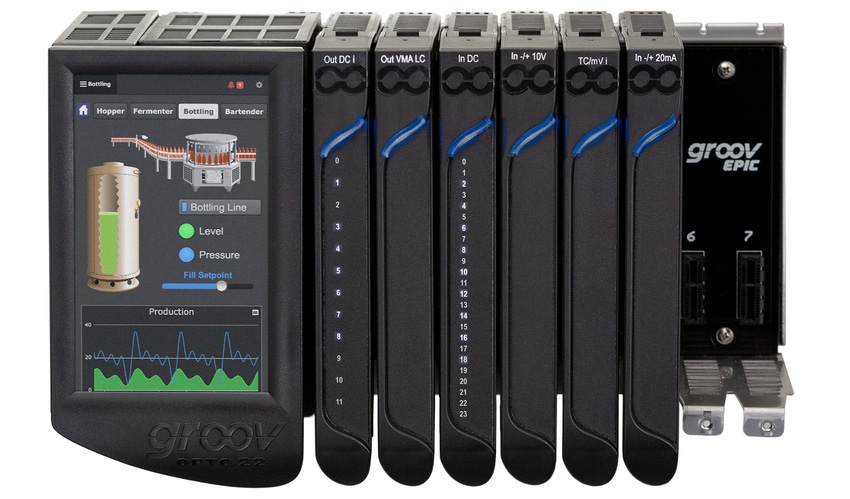Web-based software makes HMIs more economical and accessible
August 2, 2018

Packaging machines are benefitting from advanced technologies in controls and connectivity to the industrial internet of things (IIoT). Here’s an example: Human-machine interface (HMI) software is breaking free of the strictures placed on it by licensing and proprietary hardware.
Arun Sinha, an engineer with Opto 22, explains how web-based architecture enables an HMI to be used on ordinary portable devices, greatly increasing its versatility and lowering its costs.
What recent advancements have you seen in HMIs for packaging machines?
Sinha: We’ve seen a migration away from PC-based HMIs with restrictive licensing for remote viewing, and from proprietary operator interface terminals, to more web-based server/client software options. These options permit the use of many different remote HMI clients, each of which can be used on-machine or remotely.
These web-based server software options are usually one of these three types, each with a built-in web server that provides access from any client device capable of hosting a web browser, such as a laptop, smartphone or tablet:
1. The first option is a hardware box, such as Opto 22’s groov Edge Appliance. The hardware box doesn’t have its own built-in HMI, but instead can serve up web pages to any connected client device.
2. The second option is a controller with a built-in HMI, such as Opto 22’s groov EPIC (pictured above). This option provides a local HMI, and any number of client HMIs, by serving up web pages to any connected device.
3. The third option is a PC-based HMI with unlimited client HMIs, such as Opto 22’s Server for Windows. This option differs from traditional PC-based approaches because the number of clients is unrestricted by licensing requirements.
What is the significance of these options?
Sinha: Each of these options allows users to view operator interface pages on devices, such as smartphones, tablets, laptops, PCs and big screen HDTVs. The software is affordable and not encumbered with limits on users or tags. This also fits in with the “bring your own device” (BYOD) trend, whereby plant personnel can access automation systems via their own laptop, smartphone or tablet—provided they have the right security credentials.
Most packaging plants have many machines from a variety of vendors, and it can be more cost-effective to buy each machine with only a limited local HMI, or none at all, and the capability to serve up HMI web pages. This also untethers plant personnel from the machine when desired, creating a more efficient workforce.
How do these advanced systems compare to the existing standard ones?
Sinha: Existing standards tend to be based on Windows PCs where the total cost of ownership can be high—for maintenance, Windows updates and software licensing. Other options are purpose-built OITs [operator interface terminals] based on expensive proprietary software and hardware, with users locked into the specific vendor’s often restrictive remote HMI options.
What are the benefits of these advancements for packaging machinery buyers/users?
Sinha: They include:
• Lower cost of ownership;
• Design once, run anywhere;
• Remote capabilities, both in plant and many miles away;
• Untethers users from machines;
• Provides common HMI interface across many machines and entire packaging lines;
• Allows plant personnel to use their own devices for operator interface, eliminating the learning curve involved with using different HMIs;
• Enables easier support from machine builder OEMs when required.
In summary, these advancements can help packaging machinery users be more flexible and efficient, while improving quality and cutting maintenance costs.
What areas in HMIs still need work and why?
Sinha: Today’s consumer devices (tablets, smartphones) offer best-in-class touchscreens, graphics, colors and responsiveness. One would expect those features to make their way into industrial HMIs as well, but it could take a while, and by then consumer devices will have made the next leap ahead.
Consumer devices allow users to pinch to zoom in or out and swipe right or left, for example. Plant personnel, especially younger workers, have come to expect this advanced functionality in their industrial HMIs.
Consumer devices sell in the billions of units per year, compared to the thousands of units for industrial HMI software packages and hardware. These devices will therefore always be way ahead on industrial HMIs, and so should be used wherever possible as HMI clients.
Another area where advancement is needed is support for more IT-friendly and cyber-secure communication protocols. This will help users more easily move data into higher level business systems, and also distribute data remotely via IIoT technologies such as MQTT [message queuing telemetry transport].
What kind of further improvements might we see in HMIs, and when?
Sinha: We’ll see better touchscreens, lower costs and better licensing arrangements with no tag or user limits.
On-board HMIs on control systems provide faster commissioning and easier troubleshooting. This feature can save thousands in costs by eliminating the need for a machine-based HMI or operator interface terminal.
This is the first in a series of articles that reports on “Advancements in…” the packaging production and machinery area. CLICK HERE to take our short survey to let us know what topics you’d like us to cover. Thanks.
*************************************************************************************
Packaging solutions come to Minneapolis: As part of the region’s largest advanced design and manufacturing event, MinnPack 2018—and the five related shows taking place alongside it—brings 500+ suppliers, 5,000+ peers and 60+ hours of education together under one roof. Register for free today.
About the Author(s)
You May Also Like


